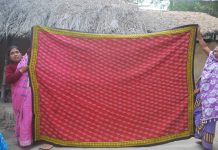Although the sophisticated technique of tie-dyeing called shibori itself dates back to the Nara period (710-794), the history of the craft here only goes back some 400 years, to when the feudal lord from the province of Bungo—now Oita Prefecture—was ordered to assist in the building of Nagoya castle.
Under the protection of the Owari clan, which ruled the area that became Aichi Prefecture, the craft was developed over the years, a whole variety of techniques having been added to produce a high quality tie-dyed craft of distinction. Because everything is done by hand, the finished article has its own peculiarities depending on the way a person ties up the cloth even when the design is the same.
Typical of cotton tie-dyeing, there are some 100 different tying techniques used in the production of multicoloured designs for formal kimono and unlined yukata. The most representative of these techniques are nui shibori, kumo shibori, miura shibori, kanoko shibori or the well known “fawn spot” tie-dyeing, and sekka shibori. A very particular effect is produced by varying the strength of the dye when indigo is used.
A pattern paper is cut according to a plan, then a rough sketch is made on silk, cotton, etc., the fabric is wrapped with thread, then dyed. The parts tied by the thread remain undyed, so the pattern emerges when the threads are removed. The work is done by dividing the labour.
The main production areas are Aichi / Nagoya-shi, Okazaki-shi, Handa-shi, Kariya-shi and Chita Peninsula.
This entry is referenced from the website of The Association for the Promotion of Traditional Craft Industries.





